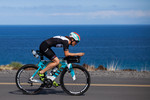Selecting A Bicycle Hydration System for Triathlon
Posted by Matt Russ on 20th Feb 2019
Even a 1% drop in body weight due to dehydration can significantly affect endurance. As blood plasma volume drops the body has to work harder to circulate a more limited amount of fluid meaning less energy to working muscles. In a triathlon the bike leg represents a great opportunity to stay or re-hydrate before the run which is the most dehydrating. For this reason selecting the best hydration system for your next triathlon may be a rare case of free speed.
Don't Take More Than You Need
Fluid is heavy and carrying 60oz of fluid on your bike for a sprint triathlon may add several pounds of unneeded ballast. Generally speaking, as long as you show up to the starting line in a well hydrated state you may not need to take any fluid on the bike for races under an hour. You are likely respirating so hard it will be difficult to consume fluids anyway. Over that mark you will need at least one water bottle. I recommend planning for 16-24oz per hour at a mostly aerobic level of intensity. Plan for the estimated time it will take you to complete the race, not distance. As you proceed to ultra-endurance events you will need to carry several bottles as well as plan for bottle swaps and aid stations.
Stay Aero
Every time you come out of your aerobars it is akin to putting the brakes on. Up to 60 percent of your on bike drag comes off the torso alone; which is why the aero position is so effective at increasing speed. A BTA (between the arms) system is generally the most effective in that it allows you to drink without altering your position if fitted correctly. BTA systems have also evolved to serve multiple purposes with accessories such as computer mounts, bento boxes, and in some cases actually reduce drag by acting as a legal fairing. Adding water bottles to the down tube or seat tube can also reduced the aerodynamic effectiveness of shaped frames. When these frames are wind tunnel tested they do not test them with water bottles attached.
Extra Bottles Ironman
For Ultra distance events you will likely need to carry several additional bottles which are often used to refill a BTA system. The most effective place to located these is behind the seat and preferably out of the aerodynamic slipstream coming off the back. This is hard to precisely determine without a wind tunnel but you can estimate it by taking some side view video. If the bottles are sticking way up above the low back then they are creating drag and should be located lower. It is best to practice refilling your BTA system without sitting up for long periods of time or at all.
Choosing a System
Compared to wheel choices, triathlon hydration systems are less complex and there are fewer choices. Generally speaking as you go up in price there is a progression in features, aerodynamics, fit, and quality. That being said a $40 system will still serve it's purpose well. More expensive systems have better mounts, are easier to refill, more adjustable, and have integrated accessories such as computer mounts. A straw that sticks up actually creates a fair amount of drag and more expensive systems allow the straw to be folded down and out of the slipstream. When choosing a system I generally recommend going with the larger size if there is a choice. You do not have to fill it to capacity for a sprint or Olympic distance event, but if you decide to compete in longer distance races you will want the bigger size.
There is also a slight safety advantage to a BTA system in that it keeps your eyes on the road and your arms in the aerobars. Sitting up to drink or remove a water bottle from its' cage can be destabilizing, especially to less initiated riders. Having your cycle computer mounted out in front of the hydration system also allows more focus on what is in front of you without having to take your eyes completely off the road.


